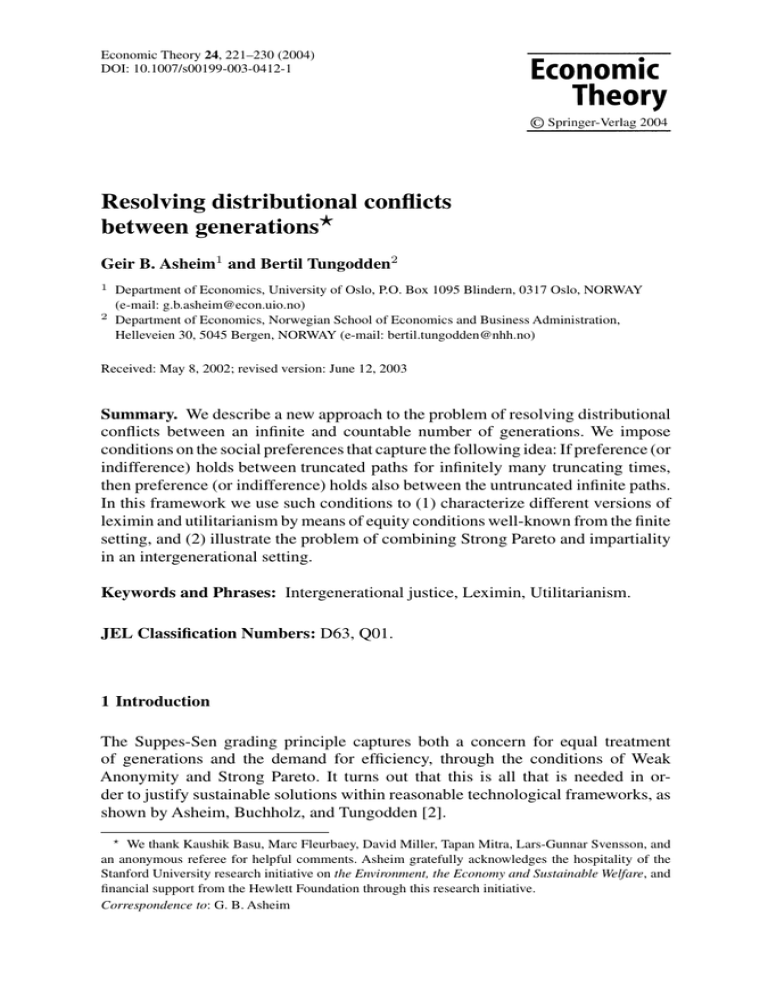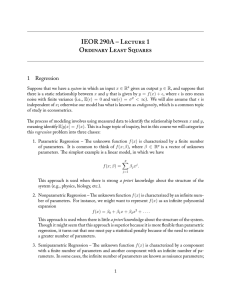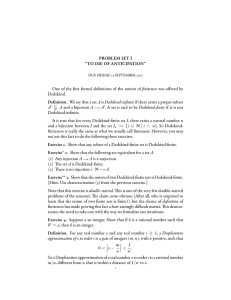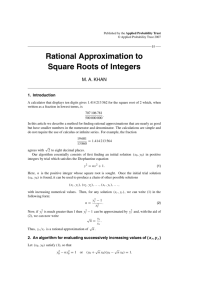Resolving distributional conflicts Geir B. Asheim and Bertil Tungodden
advertisement

Economic Theory 24, 221–230 (2004)
DOI: 10.1007/s00199-003-0412-1
Resolving distributional conflicts
between generations
Geir B. Asheim1 and Bertil Tungodden2
1
2
Department of Economics, University of Oslo, P.O. Box 1095 Blindern, 0317 Oslo, NORWAY
(e-mail: g.b.asheim@econ.uio.no)
Department of Economics, Norwegian School of Economics and Business Administration,
Helleveien 30, 5045 Bergen, NORWAY (e-mail: bertil.tungodden@nhh.no)
Received: May 8, 2002; revised version: June 12, 2003
Summary. We describe a new approach to the problem of resolving distributional
conflicts between an infinite and countable number of generations. We impose
conditions on the social preferences that capture the following idea: If preference (or
indifference) holds between truncated paths for infinitely many truncating times,
then preference (or indifference) holds also between the untruncated infinite paths.
In this framework we use such conditions to (1) characterize different versions of
leximin and utilitarianism by means of equity conditions well-known from the finite
setting, and (2) illustrate the problem of combining Strong Pareto and impartiality
in an intergenerational setting.
Keywords and Phrases: Intergenerational justice, Leximin, Utilitarianism.
JEL Classification Numbers: D63, Q01.
1 Introduction
The Suppes-Sen grading principle captures both a concern for equal treatment
of generations and the demand for efficiency, through the conditions of Weak
Anonymity and Strong Pareto. It turns out that this is all that is needed in order to justify sustainable solutions within reasonable technological frameworks, as
shown by Asheim, Buchholz, and Tungodden [2].
We thank Kaushik Basu, Marc Fleurbaey, David Miller, Tapan Mitra, Lars-Gunnar Svensson, and
an anonymous referee for helpful comments. Asheim gratefully acknowledges the hospitality of the
Stanford University research initiative on the Environment, the Economy and Sustainable Welfare, and
financial support from the Hewlett Foundation through this research initiative.
Correspondence to: G. B. Asheim
222
G. B. Asheim and B. Tungodden
However, there are two problems with this approach. First, even if we accept
this justification for sustainability, there exists the further problem about how to resolve distributional conflicts between generations that go beyond the sustainability
question. Second, it has been argued that the Suppes-Sen grading principle cannot
capture impartiality among an infinite and countable number of generations in a
satisfactory manner (Liedekerke and Lauwers [20]). In the following, we consider
both these problems.
In Sections 3–5, we go beyond the sustainability question by introducing conditions on (strict) preference that turn out to bring the infinite intergenerational setting
into line with the framework for distributive justice in the finite setting. These conditions capture the idea that one infinite utility path should be considered strictly
better than another path if the head of the former is considered strictly better than
the head of the latter at infinitely many truncating times. Within this framework, we
show how equity conditions well-known from the finite setting can be applied to the
debate on infinite intergenerational justice. Moreover, we provide characterizations
of intergenerational versions of leximin and utilitarianism.
In Section 6, we consider the possibility of extending impartiality among an
infinite number of generations through the idea that one infinite utility path should
be considered indifferent to another path if the head of the former is considered
indifferent to the head of the latter at infinitely many truncating times. It turns out,
however, that this approach does not move us beyond Weak Anonymity unless we
are ready to reject Strong Pareto.
The formal framework – including the conditions of Weak Anonymity and
Strong Pareto – are introduced in Section 2.
2 The framework
There is an infinite number of generations t = 1, 2, . . . . The utility level of generation t is given by ut , which should be interpreted as the utility level of a representative member of this generation.
A binary relation R over paths 1 u = (u1 , u2 , . . . ) starting in period 1 expresses
social preferences over different intergenerational utility paths. Any such binary
relation R is throughout assumed to be reflexive and transitive on the countably
infinite Cartesian product R∞ of the set of real numbers R. The social preferences
R may be complete or incomplete, with I denoting the symmetric part, i.e. indifference, and P denoting the asymmetric part, i.e. (strict) preference. For any utility
path 1 u = (u1 , u2 , . . . ) and any time T , 1 uT = (u1 , u2 , . . . , uT ) denotes the truncation of 1 u at T , and 1 ũT is a permutation of 1 uT having the property that 1 ũT is
non-decreasing. Refer to 1 uT as the T -head and T +1 u as the T -tail of 1 u.
A path 1 v weakly Pareto-dominates another path 1 u if every generation is
weakly better of in 1 v than in 1 u and some generation is strictly better off. Assume
a technology determining a set of feasible paths. A feasible path 1 v is said to be
efficient if there is no other feasible path that weakly Pareto-dominates it. A feasible
path 1 v is said to be R-maximal, if there exists no feasible path 1 u such that 1 u P 1 v.
A feasible path 1 v is said to be R-optimal, if 1 v R 1 u for any feasible path 1 u. Any
R-optimal path is R-maximal, while the converse need not hold if R is incomplete.
Resolving distributional conflicts between generations
223
The following two conditions are imposed on the social preferences.
Condition SP (Strong Pareto). For any 1 u and 1 v, if vt ≥ ut for all t and vs > us
for some s, then 1 v P 1 u.
Condition WA (Weak Anonymity). For any 1 u and 1 v, if for some finite permutation π, vπ(t) = ut for all t, then 1 v I 1 u.1
The Suppes-Sen grading principle RS deems two paths to be indifferent if one
is obtained from the other through a finite permutation, and one utility path to be
preferred to another if a finite permutation of the former weakly Pareto-dominates
the other. The binary relation RS is a subrelation2 to the social preferences R if and
only if R satisfies SP and WA.
3 Preference continuity
The relation generated by SP and WA – the Suppes-Sen grading principle, RS
– is incomplete. In the following three sections, we pose the problem: how to
resolve distributional conflicts between generations when comparing paths that are
RS -maximal, by extending (strict) preference beyond what the Suppes-Sen grading
principle entails. We will impose conditions that establish a link to the standard finite
setting of distributive justice, by transforming the comparison of any two infinite
utility paths to an infinite number of comparisons of utility paths each containing
a finite number of generations. We may then apply well-known equity conditions
from the traditional literature on distributive justice. There are two options.3
Condition WPC (Weak Preference Continuity). For any 1 u and 1 v, if ∃T̂ ≥ 1
such that ∀T ≥ T̂ , (1 vT , T +1 u) P 1 u, then 1 v P 1 u.
Condition SPC (Strong Preference Continuity). For any 1 u and 1 v, if ∃T̂
≥ 1 such that ∀T ≥ T̂ , (1 vT , T +1 u) R 1 u, and ∀T̂ ≥ 1, ∃T ≥ T̂ such that
(1 vT , T +1 u) P 1 u, then 1 v P 1 u.
These conditions can alternatively be formulated as follows. Write
R :=
∞ ∞
{(1 v, 1 u)| (1 vT ,
T +1 u) R 1 u} .
T̂ =1 T =T̂
A permutation, i.e., a bijective mapping of {1, 2, . . . } onto itself, is finite whenever there is a T
such that π(t) = t for any t > T .
2 R is said to be a subrelation to R if (i) v I u implies v I u and (ii) v P u implies
1
1
1
1
1
1
1 v P 1 u, with I and I and P and P denoting the symmetric and asymmetric parts of R and
R , respectively.
3 This approach is in spirit related to the concepts of ‘overtaking’ (Atsumi [3]; von Weizsäcker [21])
and ‘agreeable plans’ (Hammond and Mirrlees [13]; Hammond [10]). WPC is implied by Axioms 3
and 4 of Brock [7]. WPC and SPC are different from Koopmans et al.’s [14] conditions of weak and
strong time perspective, which involve the evolution of welfare differences between (1 wT , T +1 vT )
T
and (1 wT , T +1 uT ) when T increases, where for all T, t ≥ 1, uT
T +t = ut and vT +t = vt .
1
224
G. B. Asheim and B. Tungodden
If R is complete for comparisons between paths having the same tail, then R denotes
the set pairs (1 v, 1 u) satisfying that beyond some T̂ there exists no T such that 1 u
is preferred to (1 vT , T +1 u). Write PT := {(1 v, 1 u) ∈ R| (1 vT , T +1 u) P 1 u}
and P∞ := {(1 v, 1 u)| 1 v P 1 u}. Then WPC means that lim inf of the sequence
PT is included in P∞ ,
∞ ∞
PT ⊆ P∞ ,
T̂ =1 T =T̂
while SPC means that lim sup of the sequence PT is included in P∞ ,
∞ ∞
PT ⊆ P∞ .
T̂ =1 T =T̂
In the following we illustrate how the conditions of WPC and SPC can be used
to characterize the intergenerational versions of the Rawlsian leximin principle and
the utilitarian principle. All binary relations considered (in Definitions 1–4) are still
incomplete. However, it follows from Svensson’s [18] Theorem 2 that there exist
completions of these binary relations.4
4 Characterizing leximin
The Rawlsian leximin principle has been stated as follows in the infinite case (see,
e.g., Asheim [1, p. 355]), where “S” indicates that RSL will be shown to correspond
to the Strong Preference Continuity:
Definition 1 (S-Leximin). For any 1 u and 1 v, 1 v RSL 1 u holds if ∃T̂ ≥ 1 such
that ∀T ≥ T̂ , either 1 ṽT = 1 ũT or there is a s ∈ {1, . . . , T } with ṽt = ũt for all
1 ≤ t < s and ṽs > ũs .
L
, that will be shown
Alternatively, there is a weaker formulation of leximin, RW
to correspond to the Weak Preference Continuity.
L
Definition 2 (W-Leximin). For any 1 u and 1 v, 1 v IW
1 u holds if ∃T̂ ≥ 1 such
L
that ∀T ≥ T̂ , 1 ṽT = 1 ũT , and 1 v PW 1 u holds if ∃T̂ ≥ 1 such that ∀T ≥ T̂ ,
there is a s ∈ {1, ..., T } with ṽt = ũt for all 1 ≤ t < s and ṽs > ũs .
We start out by characterizing RSL . It is well-known that the leximin principle
covering finite cases can be characterized by the Suppes-Sen grading principle and
the equity condition suggested by Hammond [11, 12].
Condition HE (Hammond Equity). If 1 u and 1 v satisfy that there exist j, k such
that uj > vj > vk > uk and ut = vt for all t = j, k, then 1 v R 1 u.
4 Svensson [18] invokes Szpilrajn’s [19] Lemma, which is non-constructive. It is an open question
whether one can construct a complete binary relation satisfying SP and WA; cf. Fleurbaey and Michel
[9]. Basu and Mitra [5] show that one cannot represent a complete binary relation satisfying SP and WA
by a SWF.
Resolving distributional conflicts between generations
225
It is not straightforward to translate this result into the infinite case.5 However,
by applying SPC, we obtain the following characterization.
Proposition 1. RSL is a subrelation to R if and only if R satisfies Strong Pareto,
Weak Anonymity, Hammond Equity, and Strong Preference Continuity.
Lemma 1. Assume that R satisfies Weak Anonymity. For any 1 u and 1 v, if ∃T̂ ≥ 1
such that ∀T ≥ T̂ , 1 ṽT = 1 ũT , then 1 v I 1 u.
Proof. For all T ≥ T̂ , 1 ṽT = 1 ũT and 1 ṽT +1 =
uT +1 . Hence, T̂ +1 v = T̂ +1 u. By WA, 1 v I 1 u.
1 ũT +1 ,
implying vT +1 =
Poof of Proposition 1. (If) Assume that R satisfies SP, WA, HE, and SPC. According
to the definition of a subrelation (cf. Footnote 2), we have to show that, for any 1 u
and 1 v, 1 v ISL 1 u implies 1 v I 1 u and 1 v PSL 1 u implies 1 v P 1 u. This divides the
if part of the proof into two subparts.
(1) Consider any 1 u and 1 v such that 1 v ISL 1 u. By definition of RSL , ∃T̂ ≥ 1
such that ∀T ≥ T̂ , 1 ṽT = 1 ũT . By WA and Lemma 1, 1 v I 1 u.
(2) Consider any 1 u and 1 v such that 1 v PSL 1 u. For T satisfying 1 ṽT = 1 ũT ,
it follows from WA that (1 vT , T +1 u) I 1 u. For T satisfying that there is a s ∈
{1, ..., T } such that ṽt = ũt for all 1 ≤ t < s and ṽs > ũs , we can construct
a T -head 1 ûT by means of a sequence of steps involving conflicts between two
generations. In particular, let
for n = 0
1 ũT
n
n
u
=
(
ũ
,
u
,
w̃
,
ũ
)
for
n = 1, . . . , T − s − 1
1 T
1 s−1
s s+1 s+n s+n+1 T
n
for n = T − s ,
(1 ũs−1 , us , s+1 w̃T ) = 1 ûT
where, for n = 1, . . . , T − s, uns = ũs + n(ṽs − ũs )/(T − s + 1) and, for
t = s + 1, . . . , T , w̃t = min{ũt , ṽt }. Then, for n = 1, . . . , T − s,
(1 unT ,
n−1
, T +1 u)
T +1 u) R (1 uT
by HE if ṽs+n < ũs+n (since ũs+n > w̃s+n > uns > un−1
) and SP if ṽs+n ≥ ũs+n
s
(since ũs+n = w̃s+n and uns > un−1
).
Hence,
by
transitivity,
s
(1 ûT ,
T +1 u) R (1 ũT , T +1 u) .
Since R satisfies SP, it follows that (1 ṽT , T +1 u) P (1 ûT , T +1 u), while WA implies
that (1 vT , T +1 u) I (1 ṽT , T +1 u) and (1 ũT , T +1 u) I 1 u. Hence, by transitivity,
(1 vT , T +1 u) P 1 u. This shows, by the definition of RSL , that ∃T̂ ≥ 1 such that
∀T ≥ T̂ , (1 vT , T +1 u) R 1 u, and ∀T̂ ≥ 1, ∃T ≥ T̂ such that (1 vT , T +1 u) P 1 u.
Since R satisfies SPC, it now follows that 1 v P 1 u.
(Only if) Assume that RSL is a subrelation to R. It is trivial to establish that
R satisfies SP, WA, and HE. To show that R satisfies SPC, assume that ∃T̂
5 Lauwers [15] characterizes the maximin relation by a version of Hammond Equity within a framework where Strong Pareto is relaxed.
226
G. B. Asheim and B. Tungodden
≥ 1 such that ∀T ≥ T̂ , (1 vT , T +1 u) R 1 u, and ∀T̂ ≥ 1, ∃T ≥ T̂ such that
(1 vT , T +1 u) P 1 u. Since RSL is a subrelation to R and RSL is complete for comparisons between paths having the same tail, this implies that ∃T̂ ≥ 1 such that ∀T ≥ T̂ ,
(1 vT , T +1 u) RSL 1 u, and ∀T̂ ≥ 1, ∃T ≥ T̂ such that (1 vT , T +1 u) PSL 1 u. By definition of RSL , this entails that 1 v PSL 1 u, which in turn implies 1 v P 1 u since RSL
is a subrelation to R. Thus, we have established that R satisfies SPC.
This result deals with an objection to the Rawlsian leximin position – that the
leximin principle is implausible because it assigns absolute priority to the interests of the worst off generation in cases where it is in conflict with the interest of
an infinite number of future generations. Proposition 1 tells us that our view on
intergenerational justice can be determined by considering a particular set of twogeneration conflicts. If we agree on assigning absolute priority to the worse off in
such a conflict, then we have to assign absolute priority to the worse off in general.
Hence, our result provides a defense for the leximin principle in the infinite setting
since it seems less difficult to accept the two-generation claim.
L
An analogous result can be established for RW
through a trivial modification
of the parts of the proof of Prop. 1 that involve SPC.
L
is a subrelation to R if and only if R satisfies Strong Pareto,
Proposition 2. RW
Weak Anonymity, Hammond Equity, and Weak Preference Continuity.
We must impose an assumption on the technological framework in order to
L
L
, since RW
ensure that there exists a maximal path according to RSL (and thus RW
L
is a subrelation to RS ). This provides the following complete justification for an
egalitarian approach to intergenerational justice.
Proposition 3. Assume a technology determining a set of feasible paths. If there
exists a feasible and efficient path 1 v with constant utility, and R satisfies Strong
Pareto, Weak Anonymity, Hammond Equity, and Weak Preference Continuity, then
1 v is the unique R-optimal path.
Proof. Any alternative feasible path 1 u provides at least one generation with lower
L
utility than does 1 v. Hence, 1 v PW
1 u for any other feasible path. It follows from
L
Prop. 2 that RW is a subrelation to R. Therefore, 1 v P 1 u for any other feasible
path, implying that 1 v is the unique R-optimal path.
It follows that the feasible and efficient path with constant utility is preferred
L
is a subto any other feasible path according to any binary relation to which RW
L
relation; in particular, this holds for RS . Hence, the egalitarian path is the unique
optimal path also under the stronger version of leximin.
5 Characterizing utilitarianism
The utilitarian overtaking criterion, introduced by Atsumi [3] and von Weizsäcker
[21], represents an important alternative approach to intergenerational justice. As
with leximin, there are two versions to consider.
Resolving distributional conflicts between generations
227
Definition 3 (Catching Up). For any 1 u and 1 v, 1 v RSU 1 u holds if ∃T̂ ≥ 1 such
T
T
that ∀T ≥ T̂ , t=1 vt ≥ t=1 ut .
U
Definition 4 (Overtaking). For any 1 u and 1 v, 1 v IW
1 u holds if ∃T̂ ≥ 1 such
T
T
U
u
,
and
v
P
u
holds
if ∃T̂ ≥ 1 such that
that ∀T ≥ T̂ , t=1 vt =
1
t
1
W
t=1
T
T
∀T ≥ T̂ , t=1 vt > t=1 ut .
As an illustration, compare 1 v = (2, 0, 2, 0, . . . ) and 1 u = (1, 1, 1, 1, . . . ).
Here 1 v PSU 1 u since 1 u never catches up with 1 v, while the utility paths are
U
incomparable according to RW
since 1 v never overtakes 1 u. Atsumi [3, p. 128]
and von Weizsäcker [21, p. 85] define optimality by catching up (i.e., 1 v is optimal
if 1 v RSU 1 u for any feasible path 1 u), while von Weizsäcker defines preference by
U
overtaking (i.e., 1 v is preferred to 1 u if 1 v PW
1 u).
To provide characterizations of these utilitarian criteria, we appeal to a weak
two-generation version of an invariance condition.6
Condition 2UC (2-Generation Unit Comparability). For any 1 u and 1 v, if 1 v R 1 u
and there exist j, k and (aj , ak ) ∈ R2 such that ûj = uj + aj , v̂j = vj + aj ,
ûk = uk + ak , v̂k = vk + ak , and ût = ut and v̂t = vt for all t = j, k, then
1 v̂ R 1 û.
Lemma 2. Assume that R satisfies Weak Anonymity and 2-Generation Unit Comparability. If 1 u and 1 v satisfy that there exist j, k such that uj − vj = vk − uk
and ut = vt for all t = j, k, then 1 v I 1 u.
Proof. Set aj = −vj and ak = −uk and form 1 û and 1 v̂ as follows: ûj = uj +aj ,
v̂j = vj + aj , ûk = uk + ak , v̂k = vk + ak , and ût = ut and v̂t = vt for all
t = j, k. Clearly, ûk = v̂j = 0 and, since uj − vj = vk − uk , ûj = v̂k , while
ût = v̂t for all t = j, k. By WA, 1 v̂ I 1 û, and by 2UC, 1 v I 1 u.
By applying Lemma 2 we overcome an objection to the catching up and overtaking criteria, namely that these criteria allow a large number of smaller gains for
many generations to outweigh a greater loss for a single generation. The following
results show that this is only a consequence of considering two-generation conflicts
where one generation’s gain equals the others loss.
Proposition 4. RSU is a subrelation to R if and only if R satisfies Strong Pareto,
Weak Anonymity, 2-Generation Unit Comparability, and Strong Preference Continuity.
Lemma 3. Assume that R satisfies the following condition: If 1 u and 1 v satisfy
that there exist j, k such that uj − vj = vk − uk and ut = vt for all t = j, k,
then 1 v I 1 u. Then it holds that for any 1 u, (1 ûT , T +1 u) I 1 u whenever ûs =
T
t=1 ut /T for all 1 ≤ s ≤ T .
6 See Sen [17], d’Aspremont and Gevers [8], Roberts [16], Basu [4], and in the infinite setting, Basu
and Mitra [6].
228
G. B. Asheim and B. Tungodden
Proof. We can construct the egalitarian T -head 1 ûT by means of a sequence of
steps involving conflicts between two generations. In particular, let
for n = 0
1 uT
n
(1 ûn , ũn+1 , n+2 uT ) for n = 1, . . . , T − 2
1 uT =
(1 ûn , ũT ) = 1 ûT
for n = T − 1 ,
n+1
n
where, for n = 1, . . . , T − 1, ũn+1 = t=1 ut − t=1 ût . Then it follows by the
, T +1 u) for n = 1, . . . , T − 1.
premise of the lemma that (1 unT , T +1 u) I (1 un−1
T
Hence, by transitivity, (1 ûT , T +1 u) I 1 u.
Proof of Proposition 4. (If) Assume that R satisfies SP, WA, 2UC, and SPC.
According to the definition of a subrelation (cf. Footnote 2), we have to show that,
for any 1 u and 1 v, 1 v ISU 1 u implies 1 v I 1 u and 1 v PSU 1 u implies 1 v P 1 u. This
divides the if part of the proof into two subparts.
(1) Consider any 1 u and 1 v such that 1 v ISU 1 u. By definition of RSU , ∃T̂ ≥ 1
T
T
T +1
T +1
such that ∀T ≥ T̂ , t=1 vt =
t=1 ut and
t=1 vt =
t=1 ut , implying
vT +1 = uT +1 . Hence, T̂ +1 v = T̂ +1 u. Let, for all 1 ≤ s ≤ T̂ , ûs = v̂s =
T̂
T̂
t=1 ut /T̂ =
t=1 vt /T̂ . By WA, 2UC, and Lemmas 2 and 3,
(1 vT̂ ,
T̂ +1 u) I (1 v̂T̂ , T̂ +1 u)
and (1 ûT̂ ,
T̂ +1 u) I 1 u .
Since 1 v̂T̂ = 1 ûT̂ and T̂ +1 v = T̂ +1 u, it follows by transitivity that 1 v I 1 u.
T
(2) Consider any 1 u and 1 v such that 1 v PSU 1 u. For T satisfying t=1 vt
T
=
follows, by adapting subpart (1), that (1 vT , T +1 u) I 1 u. For T
t=1 ut , it
T
T
T
satisfying that t=1 vt > t=1 ut , let, for all 1 ≤ s ≤ T , ûs = t=1 ut /T and
T
v̂s = t=1 vt /T . By WA, 2UC, and Lemmas 2 and 3,
(1 vT ,
T +1 u) I (1 v̂T , T +1 u)
and (1 ûT ,
T +1 u) I 1 u .
Since R satisfies SP, it follows that (1 v̂T , T +1 u) P (1 ûT , T +1 u). Hence, by transitivity, (1 vT , T +1 u) P 1 u. This shows, by the definition of RSU , that ∃T̂ ≥ 1 such that
∀T ≥ T̂ , (1 vT , T +1 u) R 1 u, and ∀T̂ ≥ 1, ∃T ≥ T̂ such that (1 vT , T +1 u) P 1 u.
Since R satisfies SPC, it now follows that 1 v P 1 u.
(Only if) Assume that RSU is a subrelation to R. It is trivial to establish that R
satisfies SP, WA, and 2UC. Arguments similar to those used in the only-if part of
the proof of Prop. 1 establish that R satisfies SPC. U
An analogous result can be established for RW
through a trivial modification
of the parts of the proof of Prop. 4 that involve SPC.
U
is a subrelation to R if and only if R satisfies Strong Pareto,
Proposition 5. RW
Weak Anonymity, 2-Generation Unit Comparability, and Weak Preference Continuity.
It is more difficult to establish conditions that guarantee that there exists an
optimal (or maximal) path according to the catching up and overtaking criteria, and
we leave such a task for another occasion.
Resolving distributional conflicts between generations
229
6 Intergenerational impartiality
According to Liedekerke and Lauwers [20, p. 163], formal impartiality is ensured by
imposing the axiom of Strong Anonymity (entailing indifference to any permutation
of utilities of an infinite number of generations). As the following example shows,
this demand cannot be combined with SP: 1 v = (1, 0, 1, 0, 1, 0, . . . ) can be attained
from 1 u = (0, 0, 1, 0, 1, 0, . . . ) by a permutation where generation 2 gets the utility
of generation 1, generation t the utility of generation t + 2 when t is an odd number,
and generation t + 2 the utility of generation t when t is an even number.
Liedekerke and Lauwers suggest to establish a framework where an acceptable
trade-off between the demands of impartiality and SP can be made. This implies a
rejection of the Suppes-Sen grading principle, which is characterized by WA (entailing indifference to any permutation of utilities of only a finite number of generations) and SP. One might think that it should be possible to find some intermediate
position, where impartiality is extended beyond WA (by entailing indifference to
some – but not all – permutations of an infinite number of generations) within a
framework satisfying SP, and hence, the Suppes-Sen grading principle.
However, if one – in analogy with WPC – imposes that an infinite utility path
should be considered indifferent to another infinite utility path if the head of the
former is considered indifferent to the latter at every point in time beyond a certain
initial phase, then it follows from Lemma 1 that no extension of WA is obtained.
On the other hand, if one – in analogy with SPC – imposes that an infinite
utility path should be considered indifferent to another infinite utility path if, at
any point in time, there is a future point in time at which the head of the former
is considered indifferent to the latter, then it is not possible to establish an equivalence relation without coming in conflict with SP: If 1 u = (0, 0, 1, 0, 1, 0, . . . ),
1 v = (1, 0, 1, 0, 1, 0, . . . ), and 1 w = (0, 1, 0, 1, 0, 1, . . . ), then such strong indifference continuity implies 1 v I 1 w and 1 w I 1 u, and by transitivity, 1 v I 1 u. This
contradicts SP.
These difficulties, associated with extending indifference beyond WA without
coming into conflict with SP, illustrate the problem of constructing a complete
binary relation satisfying SP and WA (cf. Footnote 4).
References
1. Asheim, G. B.: Unjust intergenerational allocations. Journal of Economic Theory 54, 350–371
(1991)
2. Asheim, G. B., Buchholz, W., Tungodden, B.: Justifying sustainability. Journal of Environmental
Economics and Management 41, 252–268 (2001)
3. Atsumi, H.: Neoclassical growth and the efficient program of capital accumulation. Review of
Economic Studies 32, 127–136 (1965)
4. Basu, K.: Cardinal utility, utilitarianism and a class of invariance axioms in welfare analysis. Journal
of Mathematical Economics 12, 193–206 (1983)
5. Basu, K., Mitra, T.: Aggregating infinite utility streams with inter-generational equity: the impossibility of being Paretian. Econometrica (in press) (2003)
6. Basu, K., Mitra, T.: Utilitarianism for infinite utility streams: a new welfare criterion and its axiomatic characterization. Mimeo, Cornell University (2003)
230
G. B. Asheim and B. Tungodden
7. Brock, W. A.: An axiomatic basis for the Ramsey-Weizsäcker overtaking criterion. Econometrica
38, 927–929 (1970)
8. d’Aspremont, C., Gevers, L.: Equity and the informational basis of collective choice. Review of
Economic Studies 46, 199–210 (1977)
9. Fleurbaey, M., Michel, P.: Intertemporal equity and the extension of the Ramsey criterion. Université
de Pau and Université de la Méditerranée (2001)
10. Hammond, P. J.: Agreeable plans with many capital goods. Review of Economic Studies 42, 1–14
(1975)
11. Hammond, P. J.: Equity, Arrow’s conditions and Rawls’ difference principle. Econometrica 44,
793–804 (1976)
12. Hammond, P. J.: Equity in two person situations – some consequences. Econometrica 47, 1127–
1135 (1979)
13. Hammond, P. J., Mirrlees, J. A.: Agreeable plans. In: Mirrlees, J. A., Stern, N. H. (eds.) Models of
economic growth, pp. 283–299. London: Macmillan 1973
14. Koopmans, T. C., Diamond, P. A., Williamson, R. E.: Stationary utility and time perspective. Econometrica 32, 82–100 (1964)
15. Lauwers, L.: Rawlsian equity and generalised utilitarianism with an infinite population. Economic
Theory 9, 143–150 (1997)
16. Roberts, K. W. S.: Interpersonal comparability and social choice theory. Review of Economic Studies 47, 421–439 (1980)
17. Sen, A. K.: On weights and measures: Informational constraints in social welfare analysis. Econometrica 45, 1539–1572 (1977)
18. Svensson, L.-G.: Equity among generations. Econometrica 48, 1251–1256 (1980)
19. Szpilrajn, E.: Sur l’extension du l’ordre partiel. Fundamenta Mathematicae 16, 386–389 (1930)
20. van Liedekerke, L., Lauwers, L.: Sacrificing the patrol: utilitarianism, future generations and infinity. Economics and Philosophy 13, 159–174 (1997)
21. von Weizsäcker, C. C.: Existence of optimal program of accumulation for an infinite time horizon.
Review of Economic Studies 32, 85–104 (1965)





